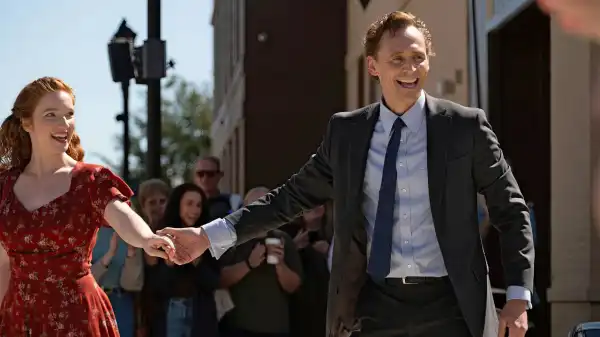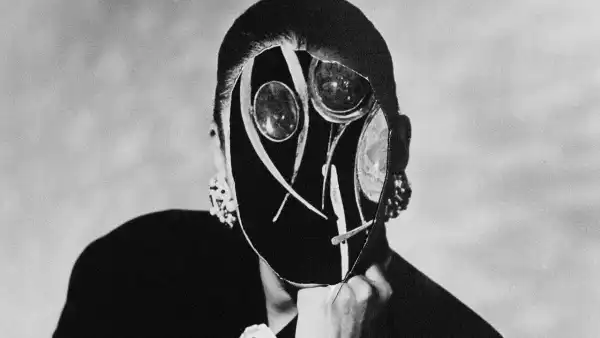
Save this storySave this storySave this storySave this story
It’s impossible to talk about Life of Chuck without touching on the ending, since that’s where the plot begins. The film unfolds in reverse, like the Stephen King short story on which it’s based. The title sets the film in its third act, subtitled “Thank You, Chuck,” an apocalyptic tale centered on schoolteacher Marty Anderson (Chiwetel Ejiofor). His lesson on the penultimate section of Walt Whitman’s “Song of Myself” — the part with the famous line “(I am large, I contain many)” — is interrupted by news of a devastating earthquake that has washed much of California into the ocean. Soon after, the parents who come to him for advice begin to panic over a global internet blackout. News of fires, floods, volcanic eruptions, plagues, loss of arable land, and mass extinctions evoke the collapse of the planet. A massacre of students outside the White House, a revolution in Russia, and conflict between India and Pakistan. Anxiety and social unrest are sweeping through the city, including Marti, as crowds of people quit their jobs or leave their homes in search of long-lost loved ones.
In the midst of the chaos, Marty notices something strange: a giant billboard featuring a bespectacled man in a business suit (Tom Hiddleston) writing in a ledger that reads, “Charles Krantz, 39 wonderful years! Thanks, Chuck!” Similar tributes begin appearing in unexpected places – on radio stations, on TV stations that are usually offline, in the form of graffiti, in the sky, and even in the windows of houses without power. Everyone wonders – who is Chuck? An undertaker (Carl Lumbly) whom Marty meets calls Chuck “the Oz of the Apocalypse.” Marty is reunited with his ex-wife, Felicia Gordon (Karen Gillan), a nurse at the local hospital, where most of the staff has left and the patients have been relocated. Despite the fact that all the beds are empty, the heart monitors next to them continue to beep at seventy-five beats per minute.
By the end of the third act, the mystery is partially solved: Chuck is at home, in bed, apparently dying, his wife Ginny (Q'orianka Kilcher) and son Brian (Antonio Raul Corbo) looking on sadly. His heart monitor is beeping at seventy-five beats per minute. The timing, so early in the plot, of Chuck's descent into world destruction almost completely undermines the second and first acts, leaving them with little more than plot details. Still, writer-director Mike Flanagan occasionally shakes up that sense of timing and rescues several scenes from the constraints of the puzzle-movie construct. He has a keen eye for the small but important details that, introduced early and echoed later, become key to the plot's construction. Yet almost nothing feels discovered. These details are inserted like Easter eggs, and the moments of realization that result feel like fan service that is justified only by familiarity rather than substance. Some scenes offer a welcome, keenly observant curiosity, like when the cell service goes out and Marty and the neighbors leave their house and point their phones at the sky, hoping for a signal. But the voiceover (voiced by Nick Offerman) dispenses information, whether backstory or foreshadowing or the characters' states of mind, with an authoritative, impersonal quality, filling in the plot holes like narrative solution.
There is, however, one key element to the film that grabs Flanagan’s attention and gives it a heartfelt tone. In the second act, “Buskers Forever,” Chuck, an accountant, attends a banking conference in an unnamed city. A drummer named Taylor (Taylor Gordon) is playing on the street, and when a bored-looking Chuck walks by, she notices him. He responds with a little juke, then begins to dance, vigorously but with control. A crowd forms, including a young woman named Janice (Annalise Basso), who is also a little juke. Chuck coaxes her to join him, and they begin to dance, responding energetically to every beat Taylor changes, delighting their immediate audience.
Watching dance is inherently delightful, and Flanagan conveys the audience’s sense of that delight without doing anything special with his camera. For a few brief moments, he seems to be watching the action along with the audience, rather than simply performing it. Yet even here the narrative freedom that the dance conveys is undermined: a voiceover states that Chuck is unaware that he has only nine months to live, and several shots during his impromptu performance show a middle-aged woman dancing in her kitchen while cooking, reducing the dance to a simplistic backstory. That backstory is developed in the final segment, “Act One: I Contain Multitudes,” the story of the young
Sourse: newyorker.com






